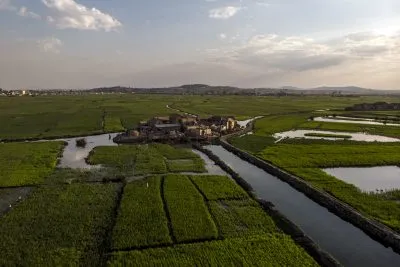Amid a frenetic environment of mobile-phone price wars and a spate of musical chairs among its top telecoms CEOs, Kenya has emerged as the East African leader in ICT innovation, bidding to emulate the US with its new Silicon Savanna in Konza. There is never a dull moment in the East African region’s telecommunications sector.
Though Kenya was the last country in East Africa to embrace ICT’s newer communication channels, it has now firmly taken the lead on ICT innovations, earning it the brand name Silicon Savanna, thanks to its award-winning revolutionary and ground-breaking mobile phone applications such as M-Pesa (mobile money transfer), M-Kesho (mobile bank account) and E-conservation (mobile tracking of elephants).
The region’s Information and Communications technology (ICT) sector, which has been hailed by economists and development technocrats as one of the major growth catalysts in the region, has been full of excitement in the last 24 months. Frenetic activity has dominated the ICT sector since 2000, ranging from innovations and the roll-out of new products to the change of shareholders, owners and even CEOs.
In 2000, Kenyan business magnate Naushad Merali teamed up with French telecoms giant Vivendi to set up Kencell, a cellular phone operator in Kenya. Kencell and Safaricom were the two operators that ruled Kenya’s mobile-phone roost. In 2004, Kencell was bought by Sudanese Mo Ibrahim, who changed its name to Celtel.
Kuwait’s Zain Telecom later bought out the Celtel Group and a new name came in – Zain. In 2010, Indian telecoms giant Bharti Airtel bought out Zain for $8.3bn and rebranded it to Airtel. As they made their foray into the Kenyan market, Airtel’s CEO Manoj Kholi revealed that his company was going to spend $150m to enhance its presence in Kenya and stratify its operations, saying Airtel was in Kenya for the long haul. Kholi’s remarks were followed by action and Airtel became the game changer. Despite altering its name and ownership four times in 11 years, Airtel shook the Kenyan telecoms market, long dominated by Safaricom, and forced the major telecoms operators in Kenya – Safaricom and Orange – to plead with the government for protection from the onslaught it unleashed.
That Airtel spoilt Safaricom’s party is an open secret. Soon after it acquired Zain and was busy settling in Kenya, Airtel wasted no time in slashing its calling rates, seeking to capture the mass market and attract new subscribers. This price reduction strategy caught all other ‘comfort zone’ operators unawares.
Safaricom’s new CEO, Bob Collymore, who took over from Michael Joseph, found himself in uncharted seas as Airtel ‘destabilised’ the market while he was still taking his place as Joseph’s successor. Collymore termed Airtel’s move as “unsustainable” and “morally reprehensible”.
Subscribers across the four major Kenyan cellular networks (Safaricom, Yu, Airtel and Orange) didn’t see it that way – instead they celebrated because of the ripple effects of Airtel’s largesse: Airtel’s move saw Safaricom and all other operators also lowering their calling rates.
In February this year, Collymore pleaded with the Parliamentary Committee on Energy, Communications and Information, stating that cheaper calling rates interfered with telecoms infrastructure reinvestment and revenue streams, and were likely to slow down industry expansion.
At the time, industry watchers saw Collymore’s move as lobbying parliament to put a ceiling on more price cuts. Kenya’s Mobile Termination Rate (MTR) of three US cents was said to be lowest in the continent.
Government intervention
As the Parliamentary Committee mulled over its next move, Collymore went ahead and in March 2010 reorganised Safaricom’s decade-old management structure, which had been put in place by Joseph in readiness to battle Airtel’s aggression.
With Parliament still dragging its feet on the price wars, President Mwai Kibaki intervened. On 18th May, after a meeting with telecoms operators, President Kibaki ordered an immediate stop to the further reduction of termination charges, to the relief of Safaricom and Orange, the two firms opposed to Airtel’s price war.
In September 2011, with the price war affecting the operators’ purse strings, Airtel managing director Rene Meza left to join Vodacom Tanzania, the leading wireless telecommunications network in Tanzania, with an 8m subscriber base. Meza, whose experience straddles Paraguay, Pakistan and Kenya, is no stranger to Tanzania as he had previously been the boss of Millicom (Tigo).
Meza’s departure revealed a quiet restructuring process within Airtel, as Shivan Bhargava took over under the new title of chief operating officer. In March, Essar Telecom, whose brand Yu has made an impact among the youth, also replaced their CEO Atul Chaturvedi, whose position was taken by Madhur Taneja from Warid Telecom in Uganda.
By March 2011, owing to the price war stirred up by Airtel, Safaricom had lost some $20m on previous year’s earnings. Its market share dropped from 79.5% to 69.9%.
The country’s telecoms regulator, the Communications Commission of Kenya (CCK), in its 4th Quarter Sector Statistical Report released in early October 2011, showed that Kenya had 25.27m mobile phone subscribers by June this year. Safaricom still maintained its market leadership with 17.35m subscribers, up from 16.71m in September 2010. It was followed by Airtel, with 3.61m subscribers, compared to 2.98m a year ago. Orange and Yu followed with 2.73m and 1.58m subscribers respectively. Revenue from mobile services was $1.04bn. The CCK figures also revealed that even compared to other operators such as Vodacom Tanzania, MTN Uganda and MTN Rwanda, Safaricom was still leading the region’s telecoms service provider.
“Overall teledensity increased to 65.15% from 65.13% in March 2011, with mobile services accounting for 64.2% … The total number of internet subscriptions rose to 4.25m from 3.84m recorded in the previous period, registering a 10.9% increase. Mobile internet subscriptions continued to dominate the total internet subscriptions and accounted for 98% of the total. The estimated number of internet users rose by 13.6% from 11.03m in the last period to 12.53m during the period under review. The increase in the internet subscriptions and users may be attributed to reduced internet charges,” the CCK reckoned.
Stung by Airtel’s price war, and now cushioned by the President Kibaki’s directive in early October 2011, Safaricom moved fast to shore up its profits by announcing an increase in calling tariffs. In response, Airtel has stuck to its position and announced that it was not revising its own calling charges.
“Airtel’s objective is to increase mobile penetration and usage through affordability and network expansion in rural areas for voice and internet services, to offer Kenyans freedom to achieve their goals and to drive GDP growth,” its CEO Bhargava said.
Even as the country moves fast in setting up Africa’s Silicon Savanna in Konza, 60km from Nairobi, there is a dull moment in the telecoms sector of East Africa’s largest economy.
Want to continue reading? Subscribe today.
You've read all your free articles for this month! Subscribe now to enjoy full access to our content.
Digital Monthly
£8.00 / month
Receive full unlimited access to our articles, opinions, podcasts and more.
Digital Yearly
£70.00 / year
Our best value offer - save £26 and gain access to all of our digital content for an entire year!
 Sign in with Google
Sign in with Google 


